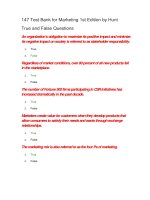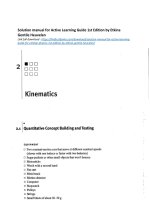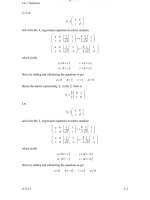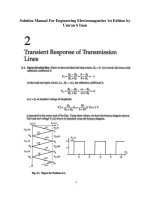Solution manual for mathematics for physicists 1st edition by lea
Bạn đang xem bản rút gọn của tài liệu. Xem và tải ngay bản đầy đủ của tài liệu tại đây (1.23 MB, 44 trang )
Solution Manual for Mathematics for Physicists 1st Edition by Lea
Chapter
1: Describing the universe
Full file
at />1. Circular motion. A particle is moving around a circle with angular velocity
Write its
velocity vector as a vector product of and the position vector with respect to the
center of the circle. Justify your expression. Differentiate your relation, and hence derive the
angular form of Newton's second law (
from the standard form (equation 1.8).
The direction of the velocity is perpendicular to
given by putting your right thumb along the vector
and also to the radius vector
and is
: your fingers then curl in the direction
Thus the vector relation we want is:
of the velocity. The speed is
Differentiating, we get:
since
is perpendicular to
The second term is the usual centripetal term. Then
is perpendicular to
and for a particle
and
since
Full file at />
Solution Manual for Mathematics for Physicists 1st Edition by Lea
Full file at />
2. Find two vectors, each perpendicular to the vector
and perpendicular to each
other. Hint: Use dot and cross products. Determine the transformation matrix
you to transform to a new coordinate system with
along your other two vectors.
We can find a vector
this is:
perpendicular to
axis along
by requiring that
and
that allows
and
axes
A vector satsifying
Now to find the third vector we choose
To find the transformation matrix, first we find the magnitude of each vector and the
corresponding unit vectors:
and
The elements of the transformation matrix are given by the dot products of the unit vectors
along the old and new axes (equation 1.21)
To check, we evaluate:
as required. Similarly
Full file at />
Solution Manual for Mathematics for Physicists 1st Edition by Lea
Full file at />
and finally:
3. Show that the vectors
(15, 12, 16),
(-20, 9, 12) and
(0,-4, 3) are mutually
orthogonal and right handed. Determine the transformation matrix that transforms from the
original
cordinate system, to a system with
axis along
and
axis along
axis along
Apply the transformation to find components of the vectors
in the prime system. Discuss the result for vector
Two vectors are orthogonal if their dot product is zero.
and
Finally
So the vectors are mutually orthogonal. In addition
So the vectors form a right-handed set.
To find the transformation matrix, first we find the magnitude of each vector and the
corresponding unit vectors.
So
Full file at />
and
Solution Manual for Mathematics for Physicists 1st Edition by Lea
Similarly
Full file
at />
and
The elements of the transformation matrix are given by the dot products of the unit vectors
along the old and new axes (equation 1.21)
Thus the matrix is:
Check:
as required.
Then:
and
Full file at />
Solution Manual for Mathematics for Physicists 1st Edition by Lea
Full file at />Since the components of the vector
rotation axis.
remain unchanged, this vector must lie along the
4. A particle moves under the influence of electric and magnetic fields
and
a particle moving with initial velocity
is perpendicular to
is not accelerated if
A particle reaches the origin with a velocity
direction of
and
coordinate system with
where
If
and
axis along
and
is a unit vector in the
set up a new
axis along
particle's position after a short time Determine the components of
the original and the new system. Give a criterion for ``short time''.
But if
is perpendicular to
then
Show that
Determine the
and
in both
so:
and if there is no force, then the particle does not accelerate.
With the given vectors for
and
then
Then , since
Now we want to create a new coordinate system with
axis along the direction of
Then we can put the -axis along
and the
axis along
The components in the
original system of unit vectors along the new axes are the rows of the transformation matrix.
Thus the transformation matrix is:
Full file at />
Solution Manual for Mathematics for Physicists 1st Edition by Lea
Full file at />
and the new components of
are
Let's check that the matrix we found actually does this:
as required.
Now let
Then
in the new system, the components of
are:
and so
Since the initial velocity is
and the path is intially parabolic:
Full file at />
the particle's velocity at time is:
Solution Manual for Mathematics for Physicists 1st Edition by Lea
Full file at />This result is valid so long as the initial velocity has not changed appreciably, so that the
acceleration is approximately constant. That is:
or
times (the cyclotron period divided by . The time may be quite long if
Now we convert back to the original coordinates:
5. A solid body rotates with angular velocity
Using cylindrical coordinates with
along the rotation axis, find the components of the velocity vector
is small.
axis
at an arbitrary point
within the body. Use the expression for curl in cylindrical coordinates to evaluate
Comment on your answer.
The velocity has only a
component.
Then the curl is given by:
Thus the curl of the velocity equals twice the angular velocity- this seems logical for an
operator called curl.
Full file at />
Solution Manual for Mathematics for Physicists 1st Edition by Lea
Full file
at />6. Starting from conservation of mass in a fixed volume
use the divergence theorem to
derive the continuity equation for fluid flow:
where
is the fluid density and
its velocity.
The mass inside the volume can change only if fluid flows in or out across the boundary.
Thus:
where flow outward (
decreases the mass. Now if the volume is fixed, then:
Then from the divergence theorem:
and since this must be true for any volume
then
7. Find the matrix that represents the transformation obtained by (a) rotating about the
axis by 45 counterclockwise, and then (b) rotating about the
What are the components of a unit vector along the original
prime) system?
The first rotation is represented by the matrix
The second rotation is a bit more tricky. Here's the diagram:
Full file at />
axis by 30 clockwise.
axis in the new (double-
Solution Manual for Mathematics for Physicists 1st Edition by Lea
Full file at />
Using the rule (1.21),
, we have:
And the result of the two rotations is:
The new components of the orignal
axis are:
8. Does the matrix
represent a rotation of the coordinate axes? If not, what transformation does it represent?
Full file at />
Solution Manual for Mathematics for Physicists 1st Edition by Lea
Draw
a diagram showing the old and new coordinate axes, and comment.
Full file
at />The determinant of this matrix is:
Thus this transformation cannot be a rotation since a rotation matrix has determinant
Let's see where the axes go:
and
while
These are the components of the original
and
and
axes in the new system. The new
axes have the following components in the original system:
where
Thus:
Full file at />
Solution Manual for Mathematics for Physicists 1st Edition by Lea
Full file at />
The picture looks like this:
Problem 8:
The matrix represents a reflection of the
and
axes about the line
9. Represent the following transformation using a matrix: (a) a rotation about the
through an angle
followed by (b) a reflection in the line through the origin and in the
-plane, at an angle 2
to the original
counter-clockwise from the positive
axis, where both angles are measured
axis. Express your answer as a single matrix. You
should be able to recognize the matrix either as a rotation about the
angle
axis
or as a reflection in a line through the origin at an angle
axis through an
to the
axis. Decide
whether this transformation is a reflection or a rotation, and give the value of
(Note: For
the purposes of this problem, reflection in a line in the
unchanged.)
axis
Since only the and
The rotation matrix is:
plane leaves the
components are transformed, we may work with
Full file at />
matrices.
Solution Manual for Mathematics for Physicists 1st Edition by Lea
Full file at />
The line in which we reflect is at 2
to the original
axis and thus at
to the new
axis. Thus the matrix we want is (see Problem 8 above):
Thus the complete transformation is described by the matrix:
The determinant of this matrix is
and
to
, and so the transformation is a reflection. It sends
so it is a reflection in the
to
axis (
10. Using polar coordinates, write the components of the position vectors of two points in a
plane:
with coordinates
and
each vector in the form
whose position vector is
and
with coordinates
What are the coordinates
and
and
(That is, write
of the point
Hint: Start by drawing the position vectors.
Problem 10
The position vector has only a single component: the
Full file at />
component. Thus the vectors are:
Solution Manual for Mathematics for Physicists 1st Edition by Lea
and
Full file
at />
The sum also only has a single component:
where, from the diagram
Thus
, and:
has coordinates
where
and thus
We can check this in the special case
as required.
This document created by Scientific WorkPlace 4.1.
Full file at />
Then
Solution Manual for Mathematics for Physicists 1st Edition by Lea
Full file at />
11. A skew (non-orthogonal) coordinate system in a plane has
axis and
axis at an angle
to the
axis along the
axis, where
(a) Write the transformation matrix that transforms vector components from the
Cartesian
system to the skew system.
(b) Write an expression for the distance between two neighboring points in the skew
system. Comment on the differences between your expression and the standard
Cartesian expression.
(c) Write the equation for a circle of radius
system.
with center at the origin, in the skew
Problem 1.11
(a) The new coordinates are:
and
Thus the transformation matrix is:
Compare this result with equation 1.21. Here the components are given by
Full file at />
Solution Manual for Mathematics for Physicists 1st Edition by Lea
Full file at />
(b)
The cross term indicates that the system is not orthogonal. We could also have
obtained this result from the cosine rule.
(c) The circle is described by the equation
a result that could also be obtained by applying the cosine rule to find the radius of
the circle in terms of the coordinates
and
12. Prove the Jacobi identity:
The triple cross product is
and thus
Since the dot product is commutative, the result is zero, as required.
13. Evaluate the vector product
in terms of triple scalar products. What is the result if all four vectors lie in a single
plane? What is the result if
result if
Full file at />
and
are mutually perpendicular? What is the
Solution Manual for Mathematics for Physicists 1st Edition by Lea
Full file at />We can start with the bac-cab rule:
Equivalently, we may write:
If all four vectors lie in a single plane, then each of the triple scalar products is zero,
and therefore the final result is also zero.
If
and
are mutually perpendicular
where the plus sign applies if the vectors form a right-handed set, and
If
then
14. Evaluate the product
Full file at />
and
in terms of dot products of
and
Solution Manual for Mathematics for Physicists 1st Edition by Lea
Full file15.
at Use
/>the vector cross product to express the area of a triangle in three different
ways. Hence prove the sine rule:
First we define the vectors
shown in the diagram.
and
that lie along the sides of the triangle, as
Then the area equals the magnitude of
Dividing through by the product
16. Use the dot product
or of
or of
Hence
we obtain the desired result.
to prove the cosine rule for a triangle:
With the vectors defined as in the diagram above,
But if
and
lie along two sides of a triangle s shown, then the third side
Thus
Full file at />
Solution Manual for Mathematics for Physicists 1st Edition by Lea
Full file at />as required.
17. A tetrahedron has its apex at the origin and its edges defined by the vectors
and each of which has its tail at the origin (see figure). Defining the normal to
each face to be outward from the interior of the tetrahedron, determine the total
vector area of the four faces of the tetrahedron. Find the volume of the tetrahedron.
Problem 1.17
With direction along the outward normal, the area of one face is
The total area is given by:
Expanding out the last product, and using the result that
:
since
The volume is 1/6 of the parallelopiped formed by the three vectors, (or 1/3 base
times height of tetrahedron) and so
18. A sphere of unit radius is centered at the origin. Points
surface of the sphere have position vectors
Full file at />
and
and
on the
Show that points
and
Solution Manual for Mathematics for Physicists 1st Edition by Lea
Full fileonatthe
/>sphere, located on a diameter perpendicular to the plane containing the points
and
where
have position vectors given by
is the angle between the vectors
and
.
Problem 1.18
The triangle
has sides given by the vectors
plane of the triangle may thus be described by the vector
This vector is normal to the plane. The vector
and
and thus
Full file at />
. The
is a unit vector, as are the vectors
since the sphere has unit radius. Thus we may write
Thus
and
and
Solution Manual for Mathematics for Physicists 1st Edition by Lea
Full file at />
To obtain both ends of the diameter, we need to add the
problem statement.
sign, as given in the
19. Show that
for any scalar field
because the order of the partial derivatives is irrelevant.
20. Find an expression for
in terms of derivatives of
and
Now remember that the differential operator operates on everything to its right, so,
expanding the derivatives of the products, we have:
This document created by Scientific WorkPlace 4.1.
Full file at />
Solution Manual for Mathematics for Physicists 1st Edition by Lea
Chapter
1: Describing the universe
Full file
at />21. Prove the identity:
Hint: start with the last two terms on the right hand side.
We expand the third term, being careful to keep the differential operator operating on
but not
The th component is:
Thus
Combining terms:
and so
as required.
22. Compute
in terms of curl
and curl
and so
23. Obtain an expression for
and hence show that
Now with
the first term is the cross product of a vector with itself, and so is zero, while the
second is zero beacuse the curl of a gradient is zero.
24. The equation of motion for a fluid may be written
Full file at />
Solution Manual for Mathematics for Physicists 1st Edition by Lea
Full file at />where
is the fluid velocity at a point,
gravity is
its density and
the pressure. the acceleration due to
Use the result of Problem 21 to show that for fluid flow that is incompressible (
constant) and steady (
Bernoulli's law holds:
Hint: express the statement ''constant along a streamline'' as a directional derivative being equal to
zero.
Use the result of problem 21 with
Write
as the gradient of the gravitational potential,
Since
constant
is perpendicular to
and dot the equation with
its dot product with
is zero, and we may move the
inside the derivative to get:
as required.
Under what conditions is
fluid?
If the flow is irrotational (
to get
equal to an absolute constant, the same throughout the
), then
and we may simplify immediately
in which case the constant of integration is the same throughout the fluid.
25. Evaluate the integral
where (a)
is the unit circle in the
We can use Stokes theorem:
Full file at />
plane and centered at the origin
Solution Manual for Mathematics for Physicists 1st Edition by Lea
Full file at />Here the surface is in the
plane, and the
component of the curl is:
and so the integral is
(b) is a semicircle of radius
origin, and
We need only the
with the flat side along the
axis, the center of the circle at the
component of the curl.
and so the integral is zero.
(c) is a 3-4-5 right-angled triangle with the sides of length
respectively, and
Using Stoke's theorem:
with the
component of the curl being:
we have
Full file at />
and
along the
and
axes
Solution Manual for Mathematics for Physicists 1st Edition by Lea
Full file at />
Or, doing the line integral:
The same result, as we expected, but the calculation is more difficult.
(d) is a semicircle of radius
origin, and
with the flat side along the
Thus the integral is
26. Evaluate the integral
where (a)
is a sphere of radius 2 centered on the origin, and
We use the divergence theorem:
Full file at />
axis, the center of the circle at the
Solution Manual for Mathematics for Physicists 1st Edition by Lea
Here
Full file
at />
and so
(b)
is a hemisphere of radius 1, with the center of the sphere at the origin, the flat side in the
plane, and
Integrating over the hemisphere, we get:
Doing the integral over
first, the first term is zero, and we have:
27. Show that the vector
has zero divergence (it is solenoidal) and zero curl (it is irrotational). Find a scalar function
that
and a vector
such that
and
and similarly for the other components.
Full file at />
such









